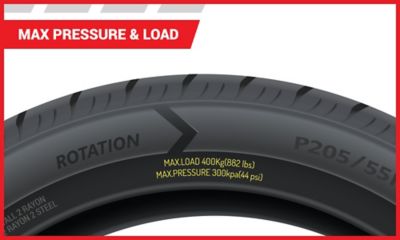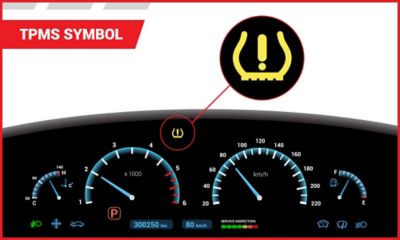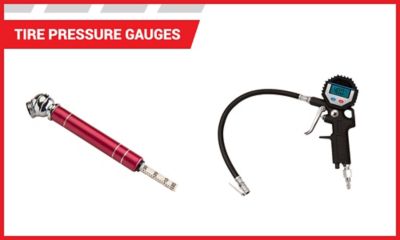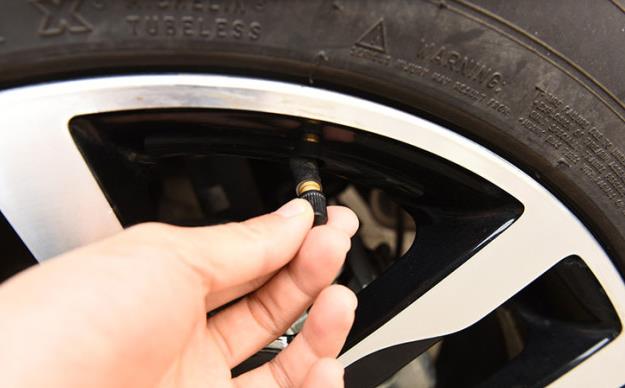Tire Pressure: Get the Scoop on Gauging, TPMS and More
If you have standard air-filled tires like most drivers today, count on your tires losing one to three pounds per square inch (PSI) each month, depending on the weather. Tires naturally and regularly lose air pressure, because the standard air that fills them contains 21 percent oxygen — and oxygen molecules are so tiny that they can permeate their rubber walls.
However, it's important to keep a regular eye on your tires' air pressure — whether you're using your vehicle's tire pressure monitoring system (TPMS) or performing monthly checks manually. A set of tires that's inflated to its recommended air pressure is one that will last longer, keep you safe, handle better and save you money on gas.
Keep reading to learn how to find your tires' optimal air pressure, how to make sense of your TPMS and how to use a tire pressure gauge to check air pressure yourself.
Achieving the Optimal Tire Pressure
You may be wondering what air pressure is best for your particular set of tires — and the answer is, it varies. The optimal air pressure is different for each set of tires.
Not sure how you should go about finding this information? You have lots of options. First, check your owner's manual — it should always include details on the recommended air pressure for your individual set of tires. You can also check your glove compartment, driver's side door jamb, trunk lid or fuel hatch.
And keep in mind that maximum air pressure does not equal optimal air pressure. You'll find your tires' maximum air pressure on the sidewall under the manufacturer's name (for example, "Max. Press. 35 PSI"). It indicates the maximum pressure needed for the tire to carry its maximum load.
That said, you could inflate your tires to their maximum pressure; however, it's not recommended, because you will notice a change in handling and your tires won't last as long. When tires are inflated to their maximum limit, the rubber protrudes at the top of the tire, causing the middle tread to wear out quickly and unevenly. Tires that are inflated this much are more prone to sliding out and blowouts. Your best bet is to strike a happy balance — not too much, not too little — in other words, the recommended air pressure. You can then reap the benefits of optimal handling and extended tire life.
Using Your TPMS
One of the simplest ways to tell if your tires are underinflated is your TPMS dashboard warning light. If your vehicle was manufactured within the last 10 years or so, it will likely have a TPMS — a battery-operated sensor that will notify you when one or more of your tires is underinflated by at least 25 percent.
Not sure if you have a TPMS? If you live in the United States and your vehicle was manufactured after September 1, 2007 — that is, if you have a passenger vehicle, light-duty truck without dual axles or bus under 10,000 pounds — it will come equipped with a TPMS. If your vehicle is of this same type but was manufactured after October 5, 2005, there is a chance that it has a TPMS.
You'll know for certain that you have a TPMS if you simply check your dashboard indicator lights upon starting your vehicle. Look for the TPMS warning light to illuminate — it may look like an exclamation mark in parentheses or like a little car with "check your pressure" nearby.
Using a Tire Pressure Gauge
If your vehicle doesn't have a TPMS — or if you'd prefer to check your air pressure yourself — get yourself a tire pressure gauge. Checking your tire's air pressure on your own is simple, and the gauge itself is inexpensive. You can buy either a traditional stick-type gauge or a battery-operated digital gauge, both of which are typically 10 dollars or less. The type you choose doesn't matter — as long as it's accurate.
Step one — Don't drive your vehicle. To get an accurate tire pressure reading, you must make sure that the tires are cold. Because tires heat up as you drive on them, if you have driven on them more than a mile, it's best to wait at least three hours before you check them, so the tires have a chance to cool down. Alternatively, you can also check them before heading out in the morning.
Step two — Locate the recommended tire pressure level for your particular set of tires. You can find this number in a variety of places, including your owner's manual. Note that the recommended pressure levels may vary for front and back tires.
Step three — Remove the valve cap for each tire. Put them in a pocket, on a workbench or somewhere inside your vehicle.
Step four — Press the gauge squarely and steadily onto the valve stem, listen for a hiss and then look at your PSI reading.
Step five — Compare your PSI reading for each tire with the recommended tire pressure numbers for your particular set of tires.
Now that you have an accurate tire pressure reading, act accordingly. If the reading is below that recommended, add some air until you reach the optimal pressure. If it's higher, simply push in on the valve to let some air out.



























